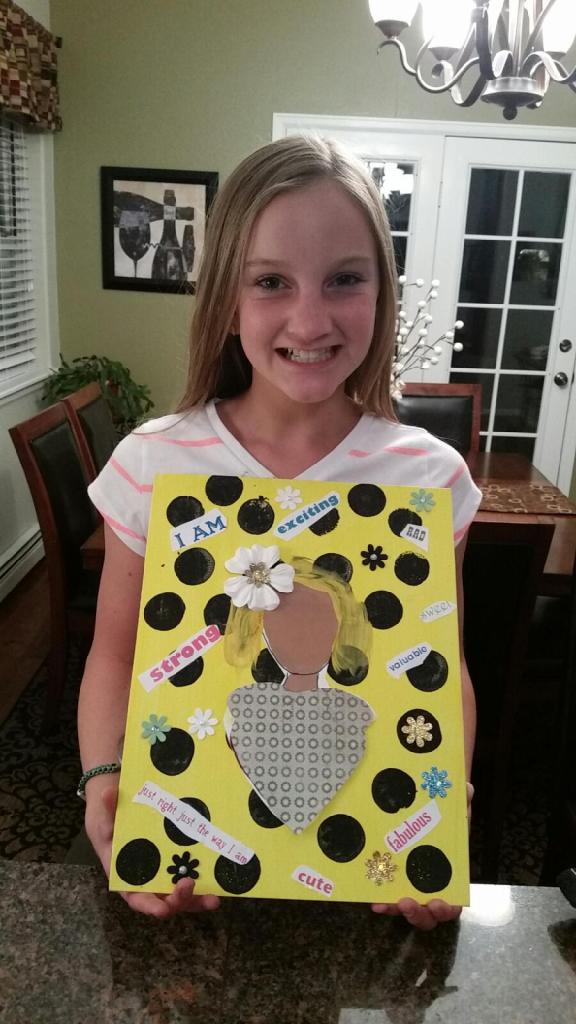
For the last 3 years our troop, with sister Troop 2214, has had a “self esteem” program in place during troop time. We spend 15-20 minutes at every meeting focusing on this because our leadership feels it is (as one of our dads likes to say) a “target rich environment”. When, really, it truly is…in a GREAT way. We have the opportunity to help make a positive impact on the self-esteem and body image of a group of girls – soon to be young women.
In a day and age where a person’s image can be used in unimaginable ways, the leadership of both troops feels this is the most important duty we have to our girls.
Each year the program changes a little, so that it isn’t always “more of the same” for the girls who have been with us since the beginning. So, this year we decided to work on the Free Being Me badge, which is a badge program created through a partnership with Dove and WAGGS (World Association of Girl Guides and Girl Scouts). The program was a good choice because it is extremely conducive to our multi-level troop in that it has activities that are similar for all groups but are completely age appropriate.

This week’s break-out session ended up going a lot longer than we anticipated because the discussion was so powerful and moving. Our troop, partnered with Juniors from our sister troop, to discuss the “costs” of the image myth. We have spent quite a bit of time defining and challenging the image myth but this discussion of what the costs associated with attaining image “perfection” went quite deep.

The point of the activity this week was to help the girls understand that money isn’t the only “cost” associated with becoming what society supposedly finds beautiful.
COSTS = unhealthy, unattainable, aren’t yourself, people look at you differently, lose friendships, fake, social problems, stress, etc….
They were broken into teams and tasked with filling in the body, on their sheet of paper, with all the things they considered “costs” of the image myth and the conversation took a really fantastic turn. The activity turned towards a lengthy talk about eating disorders when one girl said “you can’t be TOO skinny!” It was a bit of an eye opener for some girls when they realized that yes, yes you can!


The girls are coming to the age where these things, unfortunately, can’t always be pushed under the rug. It is our sincerest hope that they never think about these things as a means to an end for themselves (which is why we spend so much time on self confidence and positive body image), and certainly not anyone they know from their small school but, guarantee in the coming years….high school and college, they are likely to know at least one person who will be afflicted. If they know the signs, they might be able to help someone “off the ledge”. And THIS is exactly why we are very proud of this program.

Please EDUCATE yourself! Make a difference in someone’s life by mentoring young people.
General:
• Almost 50% of people with eating disorders meet the criteria for depression.1
• Only 1 in 10 men and women with eating disorders receive treatment. Only 35% of people that receive treatment for eating disorders get treatment at a specialized facility for eating disorders.2
• Up to 24 million people of all ages and genders suffer from an eating disorder (anorexia, bulimia and binge eating disorder) in the U.S.3
• Eating disorders have the highest mortality rate of any mental illness.4
Students:
• 91% of women surveyed on a college campus had attempted to control their weight through dieting. 22% dieted “often” or “always.”5
• 86% report onset of eating disorder by age 20; 43% report onset between ages of 16 and 20.6
• Anorexia is the third most common chronic illness among adolescents.7
• 95% of those who have eating disorders are between the ages of 12 and 25.8
• 25% of college-aged women engage in bingeing and purging as a weight-management technique.3
• The mortality rate associated with anorexia nervosa is 12 times higher than the death rate associated with all causes of death for females 15-24 years old.4
• Over one-half of teenage girls and nearly one-third of teenage boys use unhealthy weight control behaviors such as skipping meals, fasting, smoking cigarettes, vomiting, and taking laxatives.17
• In a survey of 185 female students on a college campus, 58% felt pressure to be a certain weight, and of the 83% that dieted for weight loss, 44% were of normal weight.16
*information taken from National Association of Anorexia Nervosa and Associated Disorders

















